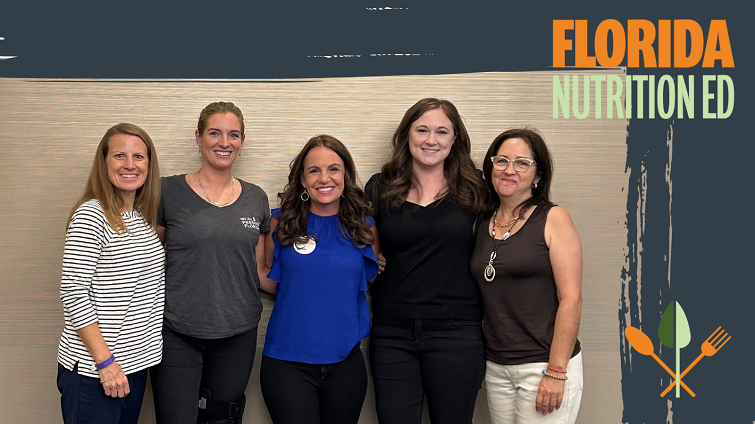Feeding Florida’s network has always been on the forefront of food insecurity by distributing healthy, nutritious foods to those who need it most. In the past year, they have gone one step further and bridged the gap between providing food in-hand and educating people on how to handle that food and lead a healthier lifestyle. Thanks to obtaining a portion of the DCF state contract to administer SNAP Ed, Feeding Florida and our food banks have established a robust statewide program, Florida Nutrition Ed, to provide education and resources to enhance the health and well-being of the state's residents.
Every food bank is running direct and indirect nutrition education in their region, serving adults and seniors in all 67 counties and youth (aged 5-17) in 26 counties. In addition to working with existing clients, the food banks partner with school districts, local organizations, senior centers, health care facilities, and adult day care centers to reach as many SNAP-eligible Floridians as they can.
At the forefront of this impactful SNAP Ed effort is Ginnifer Barber, a Registered and Licensed Dietitian Nutritionist who currently serves as Feeding Florida's Director of Florida Nutrition Education. With extensive experience as a registered dietitian and a background in state agency leadership, Ginnifer oversees the statewide SNAP nutrition education program, from implementation to administration. Her career encompasses 25 years of dedicated service in nutrition and public health, focusing on creating a system-wide impact across the food, wellness, and healthcare sectors.
Let's dive into our conversation with Ginnifer to learn more about the program’s efforts and future aspirations.
Q: How does the SNAP Ed program complement the efforts of Feeding Florida and its network of food banks in addressing hunger and food insecurity in the state?
A: While food banks address under-resourced households, SNAP Ed specifically tackles nutrition insecurity. It equips the food bank network with another valuable tool - nutrition education. Food banks provide food, and then SNAP-Ed educates individuals on the best way to prepare it to nourish their bodies. This education centers on preventing conditions like overweight and obesity, diabetes, and hypertension. SNAP Ed also emphasizes the importance of physical activity and educates people on ways to stretch their food dollars.
Q: What makes Feeding Florida’s approach to SNAP Nutrition Education unique? What do you have that others don’t?
A: Feeding Florida and its network of food banks offer healthy and dependable solutions to end hunger across all 67 counties in the state. With more than 2,400 partner charitable agencies, they serve 3.1 million hungry Floridians. The uniqueness lies in their extensive network, which helps them efficiently reach those who can benefit most from their services.
In addition, Feeding Florida developed an online platform for virtual Nutrition Education classes, helping to meet people’s needs regardless of their ability to physically attend a class. These free, online courses can be done at the person’s pace from the comfort of their own home, and they are getting valuable, helpful resources that will encourage a healthier lifestyle.
Q: How do the food banks engage in SNAP Ed? What does that structure look like, and can you provide some examples of their programming?
A: Food banks collaborate with local communities to partner with schools, senior centers, and their own food banks for direct education, indirect education, and Policy, Systems, and Environmental (PSE) activities.
Direct education is conducted by trained nutrition educators using evidence-based curriculums approved by USDA. These curriculums are used all over the country and are tailored to age groups and even cultures. We encourage our nutrition educators to conduct food demonstrations too. This is a way to engage all senses. Food is much more fun to learn about if you can see it, touch it, smell it, and most importantly, taste it!
PSE activities are about creating change- in systems, policy, or in the environment. A PSE activity can range from our team participating in the State Health Improvement Plan to creating healthy food pantries to help people make the most nutritious food choices when visiting a pantry. We can even change the signage at the local grocery store or community center to help people make good food choices.
Q: What are some common misconceptions about the SNAP Ed program that you often hear?
A: A common misconception is that SNAP Ed is primarily focused on helping people apply for SNAP benefits. The is not our role. We concentrate on providing nutrition education to SNAP-eligible participants. Our education is tailored to increase physical activity, help individuals stretch their food budgets, and prevent preventable diseases.
Q: What does the future look like for Florida Nutrition Ed?
A: We're constantly looking to adapt to our audience and improve our services. Currently, we offer online education opportunities, but we aim to expand them to reach more people who may not be able to attend in-person classes. These changes to our online platform would include offering more nutrition education classes, adding food demonstrations, and hopefully developing cooking shows.
We also want to work with local and state governments to stress the importance of providing nutrition education to help people make improved food choices to address obesity and other disease prevention in nutrition insecure households.
In addition, we would like to continue to grow our network and expand upon the tremendous job our entire team has done in this first year of programming. We’d like to expand enough to create our own evidence-based curriculum specific to Floridians (food choices, cultures, language, etc.)
For more information about SNAP Ed in Florida and to access their resources visit floridanutritioned.org.


